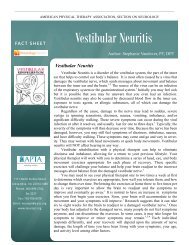Practice Guidelines for BPPV - Neurology Section
Practice Guidelines for BPPV - Neurology Section
Practice Guidelines for BPPV - Neurology Section
You also want an ePaper? Increase the reach of your titles
YUMPU automatically turns print PDFs into web optimized ePapers that Google loves.
Vestibular SIG Newsletter <strong>BPPV</strong> Special Edition<br />
Stop the World-I want to get off<br />
By Michael Shubert (continued from page 5)<br />
This principal becomes critical <strong>for</strong> diagnosing hSCC- <strong>BPPV</strong> as the<br />
otoconia can be thought of moving towards or away from the<br />
utricle/cupula, with a resultant nystagmus. Additionally critical<br />
is to know that the cupulae of the hSCC are anteriorly<br />
positioned in the head. If you were to make a fist with each<br />
hand and hold your arms in front of you in a flat horizontal<br />
circle, your fists would represent the cupula from each hSCC.<br />
If the otoconia are freely floating in the middle or<br />
posterior arms of the hSCC, the resulting nystagmus will be<br />
short-lived (generally less than 60 seconds) and will beat<br />
towards the earth regardless of head direction (geotropic),<br />
when in a side lying position. When the otoconia move towards<br />
the cupula, the nystagmus will be of greater velocity than the<br />
nystagmus generated from the otoconia moving away from the<br />
utricle (due to the excitation-inhibition asymmetry). There<strong>for</strong>e,<br />
free floating otoconia in the left horizontal canal will generate a<br />
left beating nystagmus in left side lye of greater velocity than<br />
the right beating nystagmus in right side lying (Figure 2A).<br />
There<strong>for</strong>e the rule <strong>for</strong> lateralizing the affected hSCC when<br />
geotropic nystagmus is identified is that the nystagmus will beat<br />
greater towards the affected ear (in the above example, the<br />
faster left beat nystagmus identifies the left hSCC as being<br />
affected).<br />
If the otoconia are adherent to the cupula of the hSCC<br />
the resulting nystagmus will be apogeotropic and typically<br />
persist beyond 1 minute. It will beat away from the earth<br />
regardless of head direction, when in a side lying position. In<br />
cupulolithiasis, the otoconia weigh down the cupula, and cause<br />
the hSCC cupula to deflect towards or away from the utricle<br />
when the head is supine and then rolled to the right or left.<br />
Thus, otoconia stuck to the cupula of the left hSCC will deflect<br />
the cupula towards the utricle (and there<strong>for</strong>e excite the<br />
afferents) when the head is rolled to the right (Figure 2B). In<br />
contrast, the left cupula would be deflected away from the<br />
utricle when rolled to the left (and inhibit the left vestibular<br />
afferents). There<strong>for</strong>e, the nystagmus in right roll will be of<br />
greater velocity than the nystagmus in left roll – again due to<br />
the excitation-inhibition asymmetry. There<strong>for</strong>e the rule <strong>for</strong><br />
lateralizing the affected hSCC when apogeotropic nystagmus is<br />
identified is that the nystagmus will be slower (or beat less)<br />
when lying on the affected ear. It is possible to have an<br />
apogeotropic nystagmus that is less than 1 minute in duration<br />
due to freely floating otoconia in the anterior arm of the hSCC<br />
(Figure 2C).<br />
In review, the duration and direction of the horizontal<br />
nystagmus are critical <strong>for</strong> diagnosis and enable the clinician data<br />
to determine the affected ear.<br />
16<br />
Un<strong>for</strong>tunately, in the case of persistent<br />
cupulolithiasis, what can’t be known is whether the<br />
otoconia are adherent to utricular or canal side of the<br />
cupula……but that discussion is <strong>for</strong> another newsletter.<br />
Wondering about Ewalds 1 st law? - The eyes move along the<br />
same axis as that of the stimulated semicircular canal.<br />
References<br />
1. Baloh RW, Jacobson K, Honrubia V. Horizontal semicircular<br />
canal variant of benign positional vertigo. <strong>Neurology</strong><br />
1993;43:2542–2549.<br />
2. Baloh RW, Yue Q, Jacobson KM, Honrubia V. Persistent<br />
direction-changing positional nystagmus: another variant of<br />
benign positional nystagmus? <strong>Neurology</strong> -995;45: 1297–1301.<br />
3. Casani A, Giovanni V, Bruno F, Luigi GP. Positional vertigo<br />
and ageotropic bidirectional nystagmus. Laryngoscope<br />
1997;107:807– 813.<br />
4. De la Meilleure G, Dehaene I, Depondt M, et al. Benign<br />
paroxysmal positional vertigo of the horizontal canal. J Neurol<br />
Neurosurg Psychiatry 1996; 60:68 –71.<br />
5. Ewald EJR. Physiologische Untersuchungen über das<br />
Endorgan des Nervus octavus (1892).<br />
6. Fife TD. Recognition and management of horizontal canal<br />
benign positional vertigo. Am J Otol 1998;19:345–351.<br />
7. Goldberg JM, Fernandez C. Physiology of peripheral neurons<br />
innervating semicircular canals of the squirrel monkey, I:<br />
resting discharge and response to constant angular<br />
accelerations. J Neurophysiol. 1971;34:635–660.<br />
8. Lee SH, Kim JS. Benign paroxysmal positional vertigo. J Clin<br />
Neurol 2010;6:51– 63.<br />
9. Lempert T. Horizontal benign positional vertigo. <strong>Neurology</strong><br />
1994;44:2213–2214.<br />
10. Lysakowski A, Minor LB, Fernandez C, Goldberg JM.<br />
Physiological identification of morphologically distinct afferent<br />
classes innervating the cristae ampullares of the squirrel<br />
monkey. J Neurophysiol. 1995;73: 1270–1281.<br />
11. McClure JA. Horizontal canal BPV. J Otolaryngol 1985; 14:30<br />
–35.<br />
12. Moon SY, Kim JS, Kim BK, et al. Clinical characteristics of<br />
benign paroxysmal positional vertigo in Korea: a multicenter<br />
study. J Korean Med Sci 2006;21:539 –543.<br />
13. Nuti D, Vannucchi P, Pagnini P. Benign paroxysmal<br />
positional vertigo of the horizontal canal: a <strong>for</strong>m of<br />
canalolithiasis with variable clinical features. J Vestib Res<br />
1996;6: 173–184.<br />
14. Prokopakis EP, Chimona T, Tsagournisakis M, et al. Benign<br />
paroxysmal positional vertigo: 10-year experience in treating 592<br />
patients with canalith repositioning procedure. Laryngoscope.<br />
2005 Sep;115(9):1667-71.

















